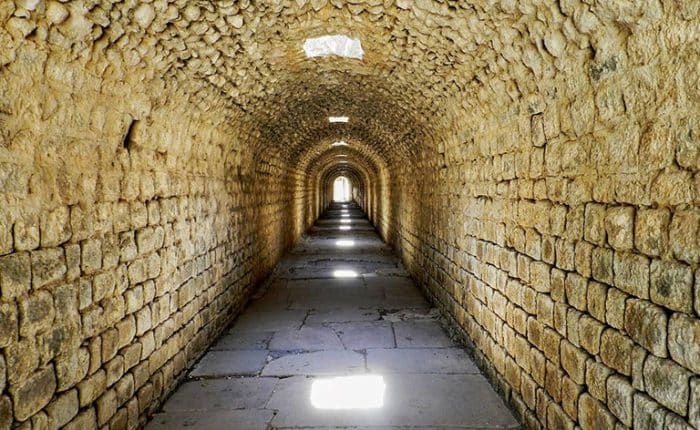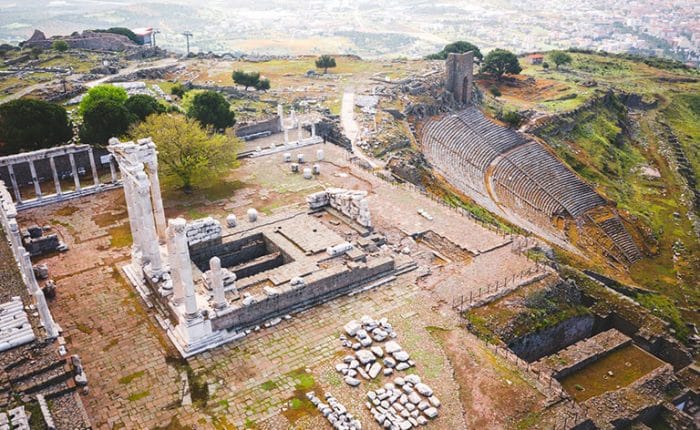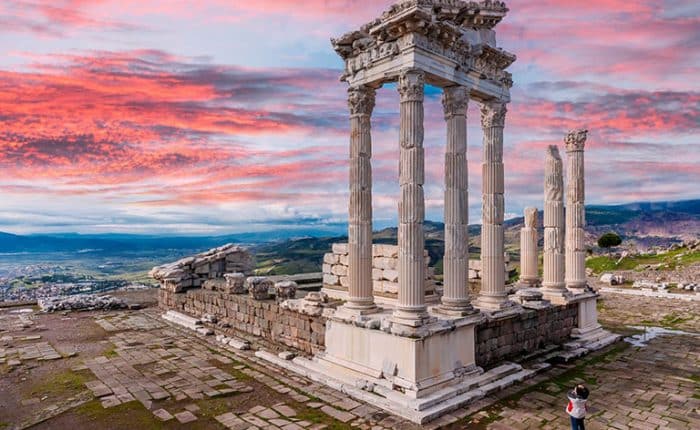The remains of Pergamon sit around 25 kilometers from the Aegean Sea in Bergama, Izmir. This was a strategic location in ancient times because it overlooked the Caicus River Valley and provided the city with easy access to the Aegean Sea. It also placed Pergamon along land and sea trading routes, making the city a center of trade and commerce and significantly contributing to its rise and wealth.
But it wasn’t always this way. Before the death of Alexander the Great and the subsequent partition of his empire among his generals, Pergamon was a hilltop fortress with a sizeable settlement on its southern side. In the years of unrest that followed, this settlement gradually embraced the city-state (polis) model and never looked back.
The city reached its greatest heights in wealth and influence in the Hellenistic period. It grew and prospered under various leaders for centuries, including the infamous Attalid Dynasty. Finally, in 133 BCE, Pergamon passed peacefully into Rome’s control, and like the cities around it, its fate was inextricably linked to the rise and fall of the Roman Empire.
A tour of Pergamon promises to be an exciting, intriguing, and scenic adventure through time. But before you get there and lose yourself in the rich history and stunning views of the ruins, you need to be adequately prepared for the tour. So, what do you need to do?
Exploring Pergamon and its environs will take the better part of a full day. So, you should arrive in the region a day or two before your tour. Fortunately, the area is well connected to the rest of Turkey and the world, with the closest airport, Izmir Adnan Menderes (ADB) Airport, around 2hr 30m drive away. Other airports in the area include Edremit and Balikesir.
Since the exploration involves a lot of hiking, don’t forget to pack some hiking attire before leaving home.
The summer months of June to September have the perfect weather for explorations. However, this also means that you may encounter heat. So, if you would like the discover the Aegean in a cooler temperature, you can choose to visit off-season.
Yes! The history is excellent, and the scenery even greater. But you don’t want to leave Izmir without trying the delicious local cuisine. You have to treat your taste buds to mouth-watering dishes like Kumru, Kadinbudu Kofte, Izmir Kofte, and Boyoz, which are served in the many restaurants in the Aegean region.
Pergamon sits in a mountainous region. Thus, come prepared with the appropriate hiking attire. You should also carry enough water and put on sunscreen or wear a hat to protect your skin from the long hours in the sun.



Pergamon enjoyed some of the highest levels of success the region has ever seen. At its height, it was a center of commerce and culture and the go-to center of medicine in the ancient world. So great was its prosperity that in his address to Christians, John the Baptist referred to the city as the seat of the devil.
The city eventually fell to natural calamities and attacks by foreign invaders. By the time of the rise of the Ottoman Empire, Pergamon was nothing but a shadow of its former self, a ghost city occupying hectares of fertile land. It lay confined to the pages of history and legend until the late 19th century when expeditions were launched, and excavations began at the ancient site.
With these, Pergamon has recovered some of its richness, albeit this time, its wealth is measured in terms of historical and aesthetic value. There are no kings to commission magnificent structures anymore, nor merchants bringing in exotic goods from the world. Today, there are only tourists and historians trying to capture the city’s splendor with their notebooks and cameras where their eyes fail.
Rising triumphantly over the ruins, the acropolis offers dramatic views of the cascading remains of Pergamon. Its also home to an impressive structure believed to be the foundations of a temple/altar dedicated to Zeus.
The altar was a beautiful work of art. Historians know this because it now stands in an incredibly well-preserved state in Pergamon Museum in Berlin, where German archeologists moved its remains in the 19th century. It’s richly decorated with impressive reliefs depicting the gigantomachy, i.e., the legendary battle between the Olympians and The Giants.
While it stood at Pergamon, the altar attracted thousands of pilgrims from all over the region. As a result, some scholars believe the apostle John referred to as ‘The Throne of Satan.’
The Temple of Athena lies north of the Temple of Zeus. It was constructed and dedicated to Athena, the city’s patron goddess, towards the end of the 4th century BCE. Move a little beyond the temple, and you’ll find yourself standing on the remains of the city’s famous library. With an estimated 200,000 parchment and papyrus documents, this library was home to the largest volume of written works in the ancient world.
Another better-preserved temple in the acropolis, the Temple of Trajan, was built between 117 and 138 by Emperor Hadrian. Its enormous remains stand dramatically against the backdrop of the valley below, which creates an awe-inspiring setting of history and scenery when coupled with the sea and sky beyond.
Every major ancient Greek city had a theater to go with its name. But as commonplace as these ancient structures are in the region, nothing quite prepares you for what you’re about to see in Pergamon. Here, the local theater embraces the mountain’s steep slope, creating the steepest structure of its kind.
In ancient times, the theater’s 80 rows could accommodate a Greco-Roman audience of 10,000. They came for civic gatherings and to be entertained. Now, you will most definitely be entertained by the 120-feet vertical climb to the top and the resulting stunning views, but take a moment to appreciate the theater’s ingenious acoustics. Why?
The theater was constructed such that an actor speaking in a natural voice on the stage could be heard even at the top-most seating structure. This acoustic marvel still works to date.
Pergamon’s infamous Asklepion is one of the most intriguing attractions you’ll visit in the region. This ancient sanctuary combined inspiring, spa treatment, and physiotherapy to make the world’s original Mayo clinic. And in doing so, it lifted the city of Pergamon to its status as the center of healing and medical science.
In fact, it was what Pergamon was best known for. So much so that millions took to the sacred road each year from all over the Greco-Roman world, seeking healing and restorative powers. And to meet their expectations, the doctors used ingenious ways best explained as you explore the Asclepios long underground tunnel.
After Pergamon, you may want to visit similar historic sites like Troy, Assos, Alexandria Troas, Nicaea, and other similar places scattered in the surrounding regions.